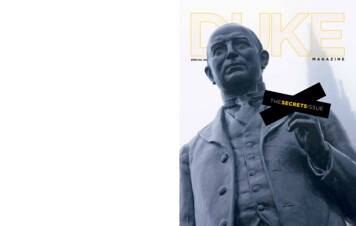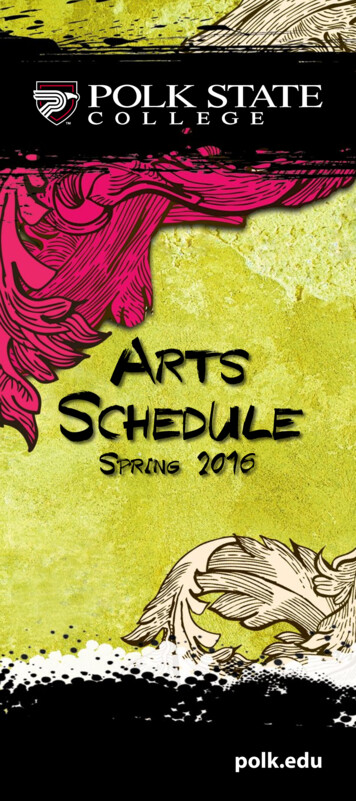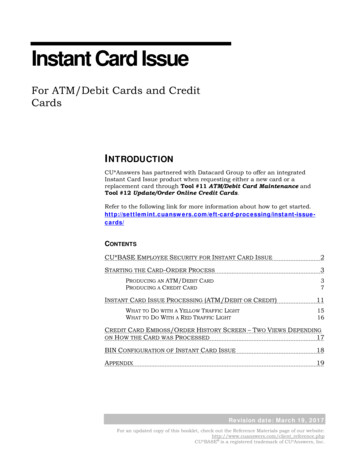
Transcription
IATEFL Slovenia MagazineWinter issue 2017, no. 72Life is full of surprises –True stories from the past to the presentAnd Then There Were Books:Using Literature in the ClassroomTap - Swipe - Pinch into EnglishTeaching a Classic American Short Storyfor Christmas: O. Henry’s “The Gift of the Magi”1
Gingerbread Man Recipe?ou needWhat yps flour 3 cuger 1 eged buttnetfoscupugar ¾brown spuc ¾assesup molc½ rp gingeonst2 cinnamdnuorpgda 1 tsking soabpst 1egsp nutmt¼ sp saltct ¼tla extralinavp 1 tsThe recipe found,tested andshared with youby Dolores How do you do it?1.2.3.4.5.Mix flour, ginger, cinnamon, bakingsoda, nutmeg and salt in large bowl.Set aside.6.7.Beat butter and brown sugar in largebowl with electric mixer on mediumspeed until light and fluffy.8.Add molasses, egg and vanillaand mix well.9.Gradually beat in flour mixture on lowspeed until well mixed.10. Cool on baking sheets 1 to 2 minutes.Press dough into a thick flat disk.Wrap in plastic wrap. Refrigerate 4hours or overnight.Preheat oven to 175 degrees C.Roll out dough to 1 cm thicknesson lightly floured work surface.Cut into gingerbread men shapeswith cookie cutter. Place 2-3 cm aparton ungreased baking sheets.Bake 8 to 10 minutes or until edges ofcookies are set and just begin to brown.Remove to wire racks and cool completely.11. Decorate cooled cookies as desired. Storecookies in airtight container up to 5 days.Recipe taken ad-men-cookies/
IATEFL Slovenia MagazineVol. 16, No 72,Winter issue 2017Published by:IATEFL Slovenia,p. p. 1677, 1001 LjubljanaEmail: info@iatefl.si, www.iatefl.siIATEFL Slovenia President: Dolores MalićIN editor: Dolores MalićPrimary school coordinator:Helena Žnidaršič SemeSecondary school coordinator:Nataša MehProfessional development coordinator:Tina BlatnikEnjoy the holidaysand let 2018 bring youlots of beautiful moments.Make the New Yeara year to remember!Printed by: Design Studio, d.o.o.Graphic design: Petra TurkArticles, letters andother contributions shouldbe addressed to IATEFL,p. p. 1677, 1001 LjubljanaEmail: info@iatefl.siIATEFL Slovenia Board Members:Dolores MalićNataša MehHelena Žnidaršič SemeCover-page photo:www.shutterstock.comISSN 1855-6833Life is full of surprises – True stories from the past to the present by Danny Singh . . .4And Then There Were Books: Using Literature in the Classroom by Irena Tertinek . . .08Tap - Swipe - Pinch into English by Janja Androić .10Teaching a Classic American Short Story for Christmas: O. Henry’s “The Gift of the Magi” by Bill Templer . . .12To be up-to-date with what is going on, visit our website: www.iatefl2.splet.arnes.si3
Life is full of surprises –True stories from the pastto the presentby Danny SinghDanny Singh, born and rai sed in London, but now basedin Rome, gives creative English language lessons andteacher training courses allover Italy and abroad. Healso offers stimulating monthly presentations on languagerelated issues at Rome’s biggest international bookshop and is visible on web TVwww.inmagicartwebtv.eu with a series of interactive English video lessons. He is author of two books, “I was ahappy man.then one day I came across Laughter Yoga”and “Learning English through the mind and the body”and is currently working on his third book, “Life is full ofsurprises”. He regularly attends Pilgrims TT summercourses as a Guest Speaker.Website: www.laughnlearn.nete-mail: singh danny@hotmail.comMenu A short history of my origins A short history of Indian partition Listening with your eyes Everything happens for a reason The language of communication Luckily I had a serious accident You are what you eatA short history of my originsA person who has a good education is highly respected, as is a doctor, irrespective ofthe medicine that he might prescribe, as isa lawyer, irrespective of the laws he mightbreak, as is an accountant, irrespective ofhow many books he has fiddled!As was the case in those days, Mum being agood wife, didn’t argue about going to theUK, much as she would miss her family. She4just did what was best for her husband and that meant,setting off for a new life in London. Let us not forget thatDad was also going to miss his family! In those days, families were seriously big! To count all the brothers and sistersyou had, one hand was not enough. Then there were cousins, uncles, aunts, parents, grandparents, nephews and nieces. People had this strange habit of getting married youngand would then set about reproducing as early and as oftenas possible.Just to give you an idea, my Dad had seven brothers andtwo sisters in total, my Mum had three sisters and onebrother. But that was nothing compared to my Dad’sgrandfather who created no less than twenty-two children! That is a hell of a lot! His poor wife was certainlyactive during her lifetime and amazingly didn’t die due toexhaustion from all the childbearing as you might think,but from an infection caused by a banal accident!A short history of Indian partitionHowever, this procedure was not so simple. In India, therewere predominantly three religions; Hindus, Sikhs and Muslims. They had lived together side by side, kids played witheach other, they worked together, looked after each otherand even got married to each other.The Hindu and Sikh leaders were happyto have a United Independent India, aswere many of the Muslim people.However, the official Muslim leaderinsisted on the idea of a separate country for Muslims called Pakistan. Thisidea was initially started by somecrackpot in Cambridge, but was nothugely supported among the Muslims.Britain however, had a policy of “divide and rule” which they had alsoused in Ireland and Palestine, withequally alarming results; the divi-To be up-to-date with what is going on, visit our website: www.iatefl2.splet.arnes.si
sion of people into one sector and government-createdborders which only brought discomfort and misery tomany people.Churchill was, if not a fan, certainly sympathetic to theMuslim idea of independence and it was he as much as anyone, who instigated the idea and encouraged the Muslimleader to pursue his dream of a separate state for Muslims.The “divide and rule” policy meant that separate schools,jobs and even elections were set up to accommodate eachreligion and this helped to breed tension which previously hadn’t existed.A similar system was used, not by the British, but to dismantle another great country, Yugoslavia, where onceagain, different ethnic groups had lived side by side formany years, then one day, stirred up by outside forces, theyembarked on a campaign of ethnic cleansing and war, leading to the elimination of Yugoslavia and the creation ofnumerous countries; Slovenia, Croatia, Bosnia and Herzegovina, Serbia, Montenegro, Macedonia and Kosovo. Thisstory and its effects are well illustrated in an excellent documentary by the Slovenian film director, Petra Seliskar,called “Mama Europa”. In this exceptional film, Petra usesher five-year old daughter as the starting point, as she asksher mother questions to try to comprehend how the creation of borders has changed the lives of people. This approach makes the film far more audience friendly than itotherwise would be, considering the subject.Listening with your eyesI believe that almost every student has taught me something. Everybody has some interests and passions, it is myaim to get them to talk about it. Someone who loves gardening will give me all the infinite details necessary topursue this activity, if I so desire. Another who workswith washing machines will explain how each part of themachine operates individually and together to ensure thecorrect operation of the machine. The only students thattaught me almost nothing were Italian politicians whomI worked with for almost twenty years. The majority wereself-obsessed and only talked about themselves, emphasizing how great they were and how much they did forpeople.At the other end of the scale, I had been working at thehospital for about ten years teaching doctors, nurses andother medical staff, when one of my students asked me ifI’d be interested in teaching a group of deaf students. Iaccepted due to my curiosity, before realising that I hadno experience with deaf people. I was assured that therewould be therapists available to assist the students. I wastold to face the students when I spoke and indeed tospeak slowly and clearly, as if I needed reminding.This would be another challenge, but I thrived on challenges, so I was looking forward to it. The students couldbe classified as young adults and they all had some kind ofcontraption in their ears, which assisted them with thedifferent sounds. They were smiling and seemed cheerful.I began speaking and they appeared to be following me. Igave them some words which students normally find difficult to pronounce and was shocked to notice how closeto perfection their responses were.I took a glance at the therapists, as if to say, are you guysmaking fun of me? Are you really deaf? And so, it continued, I talked, they replied with an almost perfect pronunciation. These people couldn’t hear me, they could onlyhear sounds. I observed them carefully to see exactly whatthey did, when I spoke. They looked at me attentively,then proceeded to imitate me. It was this that made theirpronunciation so good. They couldn’t hear the sound, butby following the exact movements of my lips and noticingthe subtle differences when I moved my jaw, cheeks,tongue, chin, nose, even eyes, they could reproduce asound that was as close to anything that any student hadever produced in any of my lessons.Thanks to these great students, I had learned how to teachgood pronunciation, not by writing words on a board,not by overspending time on the phonetic charts whereregional accents made a mockery of the sounds anyway,but by facing my students, getting them to watch me,observe every movement that I made, then to imitate me,to make every identical move!Everything happens for a reasonI went along at some unearthly hour of the morning, onlybecause I was curious to see who Mr. Bertolucci had selected in front of me. On arrival, I and a small group ofTo be up-to-date with what is going on, visit our website: www.iatefl2.splet.arnes.si5
others were told that some of us would dance, while theothers would pretend to be drunk and overfed after thewedding meal. I said, yes, I can be drunk and overfed, I’mgood at that! No, you’re going to dance, was the reply.What? I can’t dance! You’re making a big mistake! Just goand dance, was the reply.I found myself paired up with a tall, slim, attractive and elegant Indian lady wearing a sari. I started by apologizing forwhat was to come. There were five couples like us who hadto dance. We began and at regular intervals, Mr. Bertolucci’svoice would bellow out, “cut”, as he expressed his dissatisfaction with the result. Our scene was supposed to last for aboutfive seconds of the film, but it took about six hours of filming. After about four hours, I began to get the hang of it andfelt far more comfortable. At the end, I was even paid. Ithought to myself, this is amazing. I can’t dance, or so I believe. Yet, Bernardo Bertolucci has just paid me in cash todance in one of his films, so I can’t be that bad.I hadn’t realised at the time, but this was to have a majoreffect on my life. Firstly, I never refused to dance afterthat, while previously I would avoid it at all costs. As Icontinued to ponder on what the purpose of all this was,as I believed that everything happens for a reason, itwasn’t until about 2007 that I began to comprehend fullywhat had happened. Dancing had been my biggest fearback in 2001, but by 2007, not only was I quite happy todance, but I was even using dance as a tool in my Englishlessons; and this had all been caused indirectly by Bernardo Bertolucci’s decision to select me, not to act themain role in his film, but to put me outside my comfortzone and force me to face my biggest fear, head on!The language of communicationMy mother on the other hand, would try to speak slowly,use different words, change her intonation, use gestures,try anything that she could to help my girlfriend understand. I was present and so acted as a kind of interpreterwhile my mother spoke in English and my girlfriend responded in Italian. This worked well until I had a desperate need to go to the toilet. I made my excuses to leave andtold them that I’d be back as soon as I could.When I returned, I could see from a distance, that thetwo of them were communicating without any problemand without any need for an interpreter, so I stood backand watched them for about ten minutes, before I returned to them. They hadn’t missed me! There was astrong empathy between them, a desire to communicate,to understand and be understood!Despite the fact that neither spoke each other’s language,they were communicating easily. Think of how many peo-6ple have difficulty communicating with others in their ownlanguage! Couples are a classic example, as one of the pairuses signals to try to communicate his or her dissatisfaction in a particular situation, but the partner just doesn’tseem to be able to get it. Communication is not onlyabout speaking a language, it’s about the desire and willingness to do everything you can to be understood.Many Italians who work for large multinational companiesoften recount horrendous stories of English speakers whotalk to groups of them, without the minimum amount ofconsideration for the fact that English is not their firstlanguage. An English teacher generally wouldn’t do this,for two reasons. One is that they are trained to adapt theirlanguage according to who is in front of them and theother is empathy. If you don’t have that, you won’t succeed in getting your message across.The research makes it clear. 55% of face-to-face communication is based on body language, 38% on tone of voiceand only 7% of communication is words. There is often noneed to speak. The body movements and facial gestures tellus everything. Correct grammar doesn’t even come into theequation, yet most traditional language learning coursesuse grammar as the basis. This perhaps explains why mostpeople find languages so difficult and perplexing.I often find myself in situations where I am surroundedby people who do not speak any of the languages that I doand vice-versa, yet we somehow manage to communicate,if we really want to.Luckily I had a serious accidentThere was however, one big problem. I tend to work better,when I have deadlines. Neither the editor, nor my personalassistant who was proof-reading my book gave me any timelimits on my work, so it was up to me to create my own!Sadly, I didn’t, which meant that between November 2013and May 2014, I had written just four chapters.Then, in late May, destiny, as it often does, came in toplay! I was returning home late from a yoga session andjust stepping onto a bus, when my phone began ringing.Normally, I waited until I was completely seated or atleast balanced on the bus, before answering the phone.However, for some mysterious reason, I tried to answerthe phone, while being totally unbalanced and as the bussped off into the night, I managed to hit my back on ametal bar, normally used to hold onto, while standing.The pain was immense! It knocked the wind out of me!Nonetheless, I tried to carry on living a relatively normallife for a couple of days, assuming that the pain wouldeventually disappear, when I realized that it wouldn’t andthat I’d need to visit the doctor.To be up-to-date with what is going on, visit our website: www.iatefl2.splet.arnes.si
The doctor touched me a few times, as I squealed in agony, then he exclaimed, “It’s OK, you’ve fractured yourribs, nothing to worry about”. Are you sure nothing isbroken, I asked? “Absolutely, otherwise you would reallybe suffering pain, he retorted”. He told me that I was todo absolutely nothing for about thirty days. Nothing?Yes, no physical exercise, no sex, no laughing, sneezing,coughing or anything similar. I went home, sat down onthe sofa and momentarily, became depressed! The summer had arrived, I had lots of free time, but I couldn’t doany exercise. What was I supposed to do? It was then, thatI remembered about the famous book I had been writing.I could continue with that I suppose, as it involves sittingstill for long periods of time and writing.In the space of four weeks, I had gone from chapter fourto chapter twenty-three. In short, most of the book hadbeen written in that month. Over the summer of 2014, Icompleted the last two chapters, had it reviewed by theproof-reader, made a few minor changes, then sent it tothe editor for examination.After lots of time discussing and altering the text, as wellas deciding on an attractive and appropriate cover, it wasfinally published on 2 April 2015, my first ever book,written in Italian, not English! A moment to be proud of,but if I hadn’t had that terrible accident, would it havehappened at all?You are what you eatProfessional sportsmen have trainers who help them followstrict diets with the aim of maximizing performance. Novak Djokovic the Serbian tennis player, has been followinga gluten free diet for years and he believes that this is one ofthe main reasons why he was able to remain at the top,winning the big grand slam tournaments one after the other, while several of his rivals couldn’t keep up with him.My dear friend Harish Chavda who sadly passed away on23 May 2017, wrote an excellent book called, “How tolose weight and be healthy – A guide to the art of eating”.In it, he said that we could eat anything we wanted. It wasnot important what you ate, but how you ate! If you ateslowly, thoughtfully, focusing on what you were eating,observing it, smelling it and tasting it, you would notonly appreciate the food far more, but also digest far moreeasily and not put on weight.Extracts taken from the forthcoming book, “Life is full ofsurprises – True stories from the past to the present”(available on Amazon).What can be said in New Year rhymes,That’s not been said a thousand times?The new years come, the old years go,We know we dream, we dream we know.We rise up laughing with the light,We lie down weeping with the night.We hug the world until it stings,We curse it then and sigh for wings.We live, we love, we woo, we wed,We wreathe our brides, we sheet our dead.We laugh, we weep, we hope, we fear,And that’s the burden of the year.(Ella Wheeler Wilcox)your IATEFL Slovenia7
And Then There Were Books:Using Literature in the Classroomby Irena TertinekThink about your favourite book. Did it bring a :) uponyour face? Or did it perhaps made you :/? Now, thinkabout your family. Does each member have a favouritebook? And by book, I mean any book, not just the dullthick books without pictures. You see, my family doesn’tread a lot of literature, yet still they have favouritebooks, books that somehow grabbed their attentionand held it until it was too late to stop reading. It wasthat (besides my greatest wish: to have a fort entirelymade out of books), that made me want to prepare activities to include literature in the upper primary schoolas a part of my MA thesis.What held my spirits up was the belief that in a world whereeveryone who has read some books has a favourite book, theproblem is not that children do not want to read. It is thatwhat we give them is, frankly, dull. Reading should be fun,and it can be, so I found some fun texts and built activitiesaround those; enjoyable activities. Literature should be interesting and exciting; hilarious 7 last line) andhas to learn a line by heart. They have three minutes to do so. Then, they allcome up to the blackboard and need to arrange themselves to recite the song incorrect order. If the T wants to make the task more difficult, he/she can set atime limit, prohibit the speaking to English only or even to poem only. If thereare more than 17 learners, write one or more than one number twice and twolearners need to say a line simultaneously. If there are less, combine two linesand some learners have to learn two. Write the numbers by hand before copyingthe poems, when you know how many learners there will be during that lesson.To let the learners have funwith the poemand throughlearning bitsby heart theyalso learn usefulchunks of language.The learners can also learn the song by heart for homework, or perform it ata school event (then they can also prepare emoticon prompts, some learnerscan play the emoticons while others recite).To be up-to-date with what is going on, visit our website: www.iatefl2.splet.arnes.si9
Tap - Swipe - Pinchinto Englishby Janja Androić1. osnovna šola Rogaška SlatinaIn February 2016 my school applied for the Erasmus KA1School Staff Mobility funding. And already that May, ourNational Agency Cmepius was able to inform us that ourapplication had been successful, so I and four colleaguesstarted to prepare for our journeys to various different countries to attend various different courses. The course I appliedfor was titled “Tap –Swipe – Pinch into English”, organisedby Euneous, and was to take place in Liverpool in May 2017.The journey started on 28 May with a flight to Manchester anda coach to Liverpool. Liverpool, the birthplace of the Fab Four,is a city in North West England located on the east bank of theMersey Estuary and has about 480,000 inhabitants. The Beatles Story, The Cavern, the Merseyside Ferry, the Tate Museum,Anfield Stadium and many more attractions were all great, butnot the main reason I’d come here.No, the main reason I’d travelled to Liverpool was to attend thecourse, which was about the use of tablets in ELT. The coursetook place at the Toxteth Annexe Conference Centre, which isjust outside the city centre. It started on 28 May with a welcome dinner, where we met out two teacher trainers, VilijenkaŠavli and Peter Rafferty, and the other participants. The realwork then began with the workshops on Monday. We hadclasses from Monday to Friday from 9am to about 4pm and afarewell class on Saturday. During the week different approaches were presented and various apps were introduced.10day 1topic of Monday’s“The paperless classroom” was thenew approachesutlessons. To start with, we talked abong approaches, andin education, reasons for changidevices in ELT.how, when and why to use mobileexamples andWe continued with facts about andWe then tried tom.challenges of the paperless classroon and shared ideascreate a tablet classroom of our owts. We ended thefor tablet use with other participan) with a reflectionday (as in fact we ended each daya learning diary.on the day’s work in the form ofday 2On Tuesday we mainly focused on how to teach andimprove listening and speaking skills using tablets.After the trainers’ presentation, we planned andcreated listening and speaking activities andevaluated our work. Formative and summativeassessment were addressed and exchange of goodpractices took place in the afternoon part of thesession.To be up-to-date with what is going on, visit our website: www.iatefl2.splet.arnes.si
day 3Wednesday was the mostactive and creative day. Wewere given two tasks whichhad to be completed by theend of the day. The title ofthe first task was “A pictureis worth a thousand words”.We visited the Tate Museumand made a photo-story usingpictures, photos, videos andvoice-overs. The second taskwas to carry out a short videoinquiry on the streets ofLiverpool. Inquiry-basedlearning is a form of activelearning which starts withposing questions or problemsand then seeking knowledgeand information throughquestioning. We finishedoff the day with the RiverExplorer Cruise on theRiver Mersey.day 4On Thursday game-basedlearning was examined andwe looked at how to includegames in our teaching.“Treasure hunt”, QR codes,Learningapps.org andQuizlet.live are just someof the useful tools to helpcreate a game-based learningactivity. Participants wereactively involved in thecreation of games asopportunities for learningand assessing. The afternoonsession then focused on howto create follow-up readingand writing activities andstrategies with tablets.We rounded off the course on Saturday. The teacher trainerspresented some tips on how to choose from among the tons ofapps mobile devices now offer and how to develop tablet habitsin the classroom. Certificates were distributed and an onlineevaluation was filled in. We all agreed that the course had beenday 5The “flipped classroom” waspresented on Friday. Flippedlearning combines onlinelearning with face-to-faceinstruction. The teacherprepares an online tutorialand learners watch this onlineand prepare for the lesson athome. The teacher can thenspend valuable class timeassisting, coaching andguiding their learners in class.Flipped learning changes theroles of learners, who becomeactively responsible for theirlearning, and teacher, whogoes from being “the sage onthe stage” to being morementor and consultant.Our teacher trainers triedto answer our questions onhow to flip our lessons andsuggested tools and apps tomake the work easier.Teachers who had tried thismodel before also presentedtheir work.excellent and offered us a lot. We also agreed that there was alot more each individual participant had to do afterwards ifthey were serious about using tablets in their classes. Certainlythere can be a lot of advantages to using tablets in the classroom, but it’s also important to be sure to use them wisely!To be up-to-date with what is going on, visit our website: www.iatefl2.splet.arnes.si11
Teaching a Classic AmericanShort Story for Christmas:O. Henry’s “The Gift of the Magi”1by Bill Templer (Shumen, Bu
Primary school coordinator: Helena Žnidaršič Seme Secondary school coordinator: Nataša Meh Professional development coordinator: Tina Blatnik Printed by: Design Studio, d.o.o. Graphic design: Petra Turk Articles, letters and other contributions should be addressed to IATEFL, p. p. 1677, 1001 Ljubljana . Churchill was, if not a fan .











